I love drawing trees; they can be complex to draw, particularly the very large ones with twisted trunks that have a lot of character. Very large trees have been around for hundreds of years; they have seen a lot in their lives. Wouldn’t it be wonderful if they could talk? We would be able to learn so much from them. Today I am going to teach you 6 steps to draw a tree.
I have included tips for most steps to help digital and paper artists create a beautiful tree. That being said, take your time and enjoy. I’ve chosen to draw a pine tree that has grown on a cliff overlooking the ocean. Its warped trunk and windswept branches are proof of the struggles it has encountered as it grew.
Supplies Needed
| Supplies | Reason for Preference |
|---|---|
| Your favorite drawing paper | You can choose any paper you like to work with. I prefer Bristol smooth because it's versatile. |
| Watercolor paint brushes | I would use small detail brushes for this. |
| Drawing pencils | If you are just starting, there is no need to spend a fortune on pencils. Inexpensive pencils from the dollar store or Amazon will work fine. |
| White gel pen | White gel pens are perfect for highlighting. |
| Watercolor or colored pencils | Black, white, 2-3 shades of brown, 2-3 shades of green. |
| Blending stumps or blending pencils | I prefer the accuracy that these give when compared to my finger. |
| Erasers | Moldable putty-type erasers and regular rubber erasers. |
1. Sketch an Outline for Your Tree Drawing
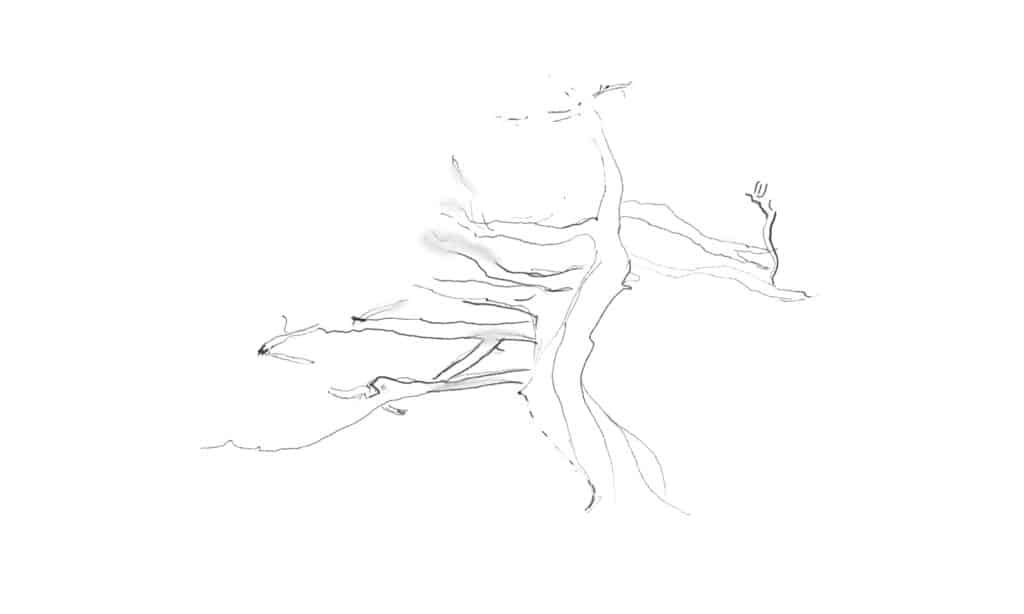
First, begin a basic shape. Unlike the dog or unicorn, I didn’t see the need for drawing circles and cylinders. Tree trunks have a few basic rules, but their final forms are shaped by the environment where they grow. Even trees of the same species growing 100 yards apart can vary significantly.
You can see that I did not draw the trunk straight. The reason for this is that the continuous winds that speed over the edge of the cliff have caused the trunk to turn and twist during growth.
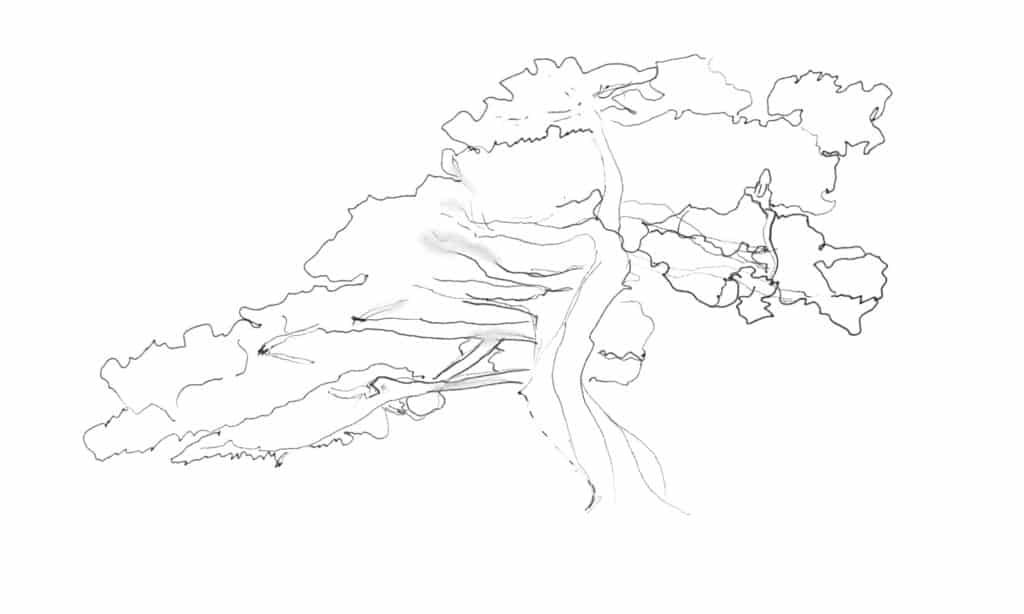
To give yourself a place to start, lightly draw a rough outline of the canopy. There won’t be many visible individual needles because it is a pine tree. They often blur together a little bit, even at short distances. Later, we will add careful highlights. Make the outline slightly jagged for now, as if bundles of needles are poking out. It doesn't need to be perfect, as we will be blending or erasing these lines later.
2. Layer the Color into the Tree Trunk
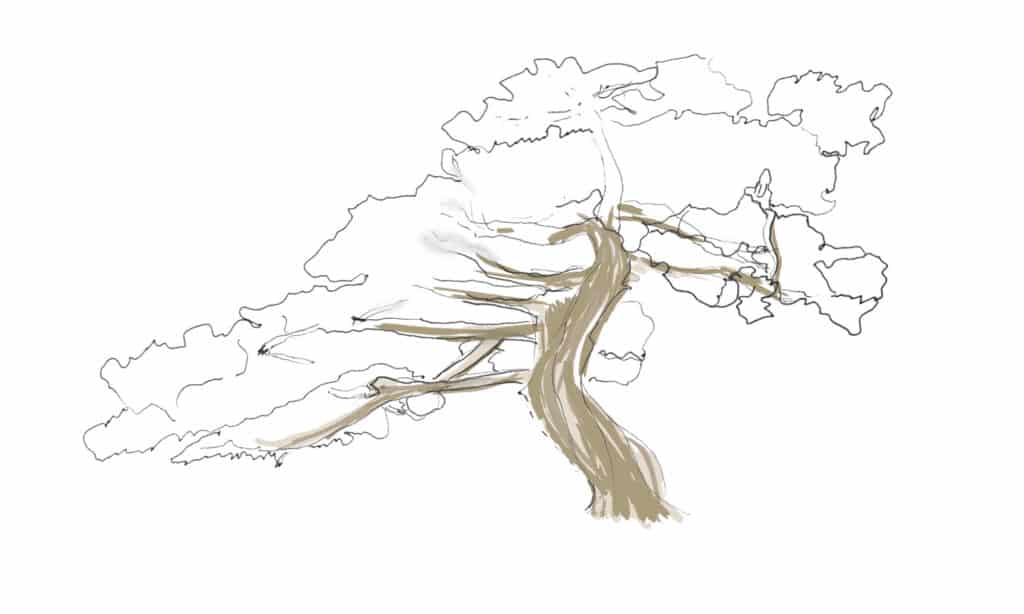
Begin by giving your tree trunk a base color. Because the trunk is twisted, it will take a few colors to make it look right. Begin with a coffee-with-cream color, light tan, and fill the branches and tree trunk with the base color. Then use either a darker tan or layer on more of the same color in streaks of color that follow the curves but do not blend them.
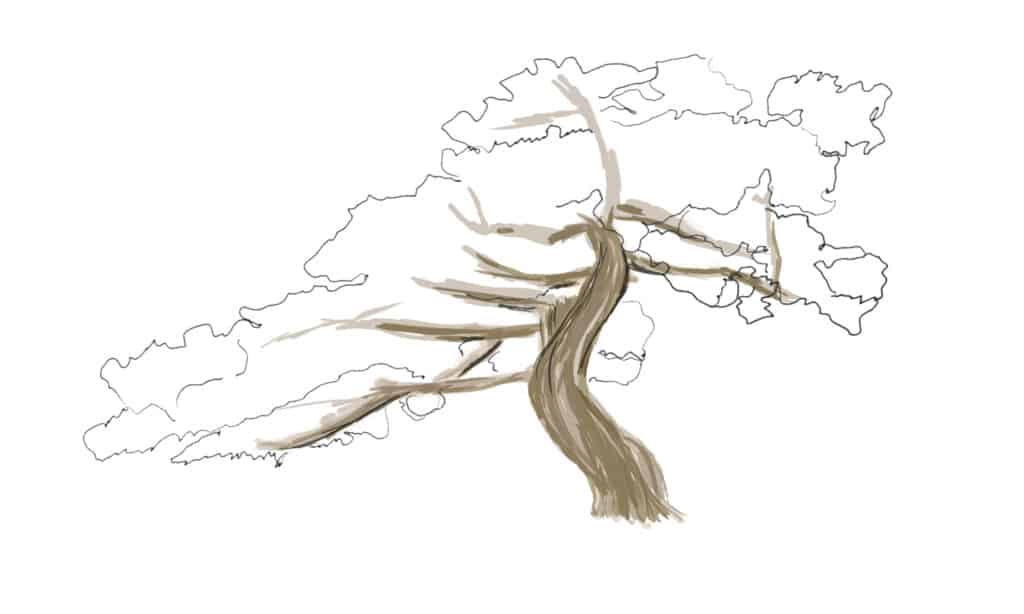
Next, build up some more color, again in streaks. Use a darker brown than the first layer. To give it some shape, you can also add a dash to the lower edges of the branches.
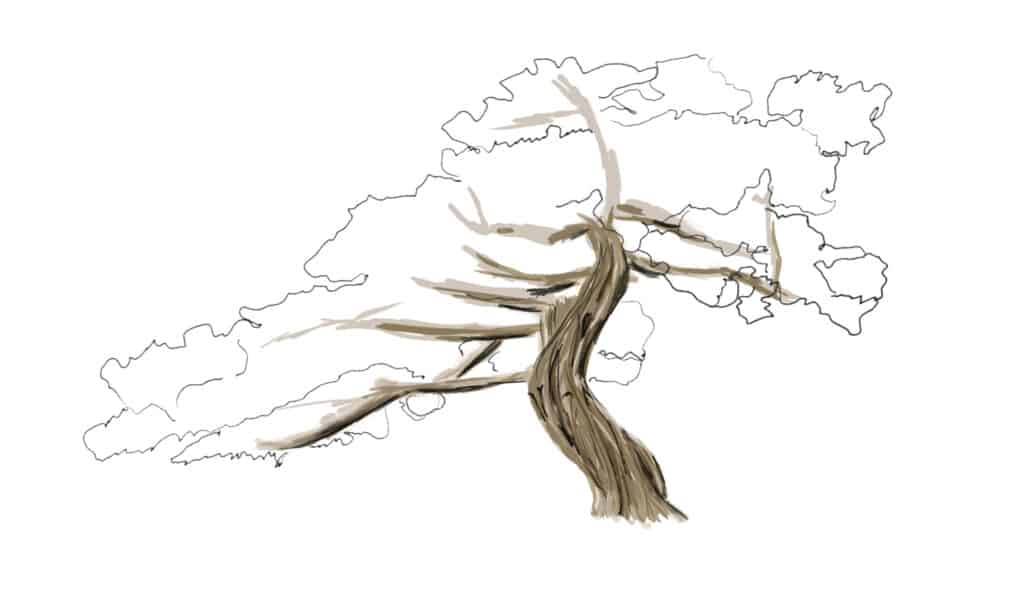
Following the twists and turns, add some darker colors to the trunk. Remember not to blend the trunks' colors together. Keep going until you're happy with it.
- Digital artists: I did all the tree trunk colors in separate layers, then merged them when I was happy with the results. Although it wasn't necessary to merge the layers, building the color this way made it possible to completely remove things I disliked without ruining the rest of the tree drawing.
- Paper artists: It's okay if you only have two shades of brown. Starting with the lightest brown, gently color the whole trunk, then use the same brown with more pressure to add a few darker streaks. Next, gently move on to the darker brown, then add more pressure for a darker stroke. If you add too much, use a moldable eraser to remove some of it.
3. Layering Color Into Your Tree Canopy
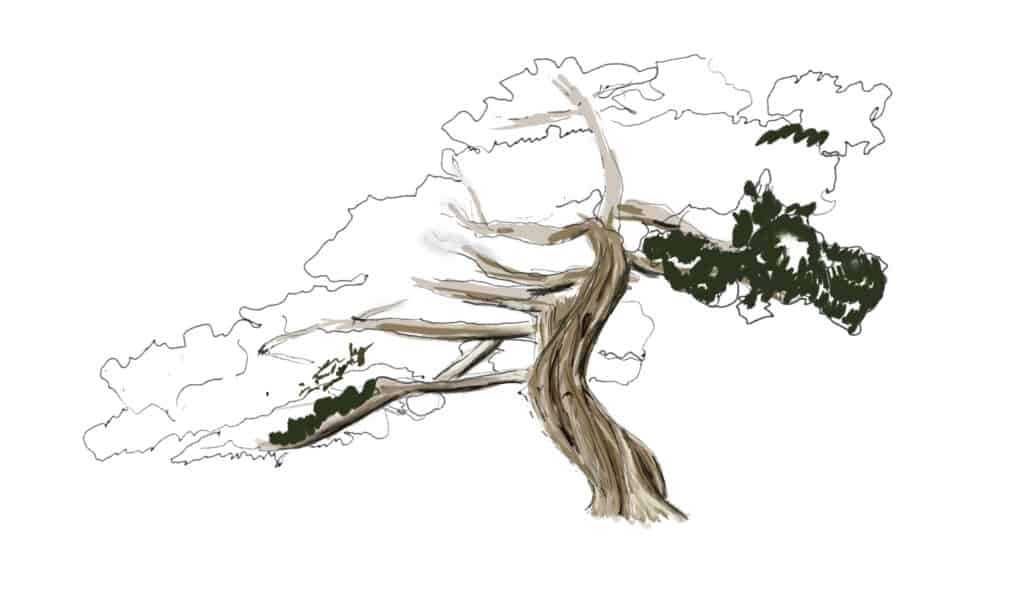
Draw the darkest shadows first. Use a relatively dark brownish-green color for the lower sections of the canopy. Make sure to leave a lot of holes for lighter colors. To create the pine needles, use a zigzag motion that makes sharp points that stick out from the clumps.

Next, use a medium green to do the main areas of the canopy. Make sure to leave lots of jagged little holes. These will be filled in with a lighter green. You can also add a smudgy clump of needles on the far side of the tree. They're farther away, so if you were looking at the real thing, you wouldn't see as much detail. Now you can remove or blend any outlines into the drawing.

Now we will add highlights as we go along. I found this to be the best way to get a beautiful tree canopy with various colors and depths. In this drawing, the sun is coming in from the left, about two-thirds up the page. Remember this! More of the lighter colors will be on that side of the page, while the darker shades are dominant on the opposite side, lower on the page.
The highlighted needles are receiving the most light, making them look brighter. Then, use a lighter green and make clumps of needles in most areas that you previously left without color. Leave some open space; you can always add more if you like, but it's difficult to remove things if you find you've done too much.
- Digital artists: Make sure you're creating new layers for the tree canopy. It will help if you find that you don't like something you did. To achieve the texture, I used a charcoal pencil brush in Photoshop for most of this drawing; it gave me the slightly cleaner edges I wanted and the texture of the tree.
- Paper artists: Take your time. Starting with the darkest shades but leaving space for the lighter color shades is the easiest way to get the detail at an appropriate level. I know artists who start with the lighter stuff and go in the other direction. I think it depends on the individual doing the drawing and the media they're using. Experiment until you're comfortable. At this point, when you're happy with the drawing, you can use watercolor brushes to wet the color very slightly to make it stand out.
4. Add a Little More Shading
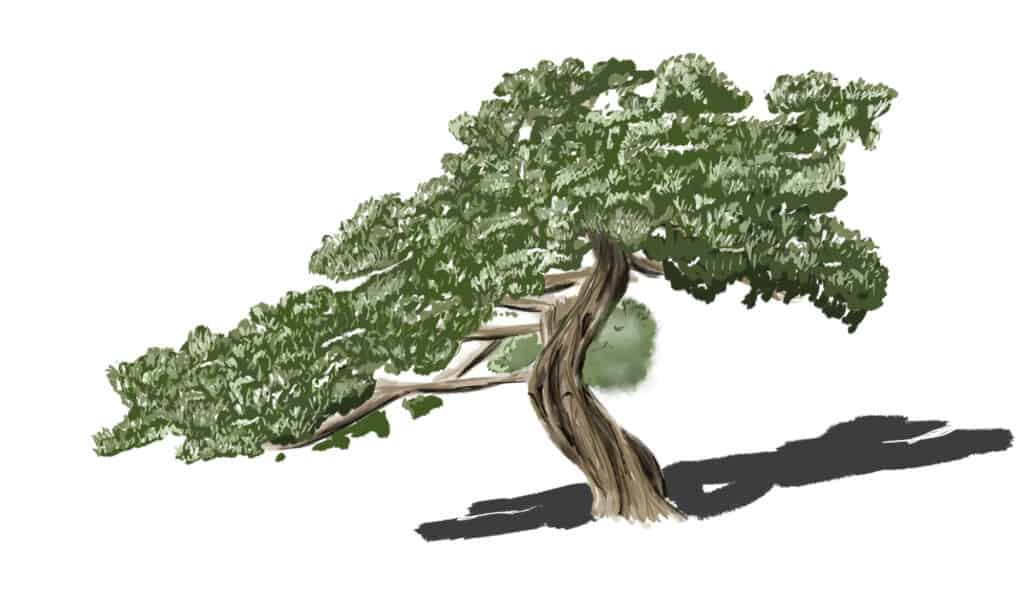
I felt my tree trunk needed more shadows and remembered trees cast a shadow on the ground. The shadows on the tree trunk were gently blended, so I didn't mess up the detail I worked so hard to create. The shadows on the tree trunk were cast through the canopy, so they are filtered and softer-edged. The shadow on the ground is just a distorted silhouette of the tree. I also added just a touch on the lower edges of the branches.
- Digital artists: Create a layer on top of the tree trunk but below the canopy. Set it to “Multiply” for these shadows.
- Paper artists: For the shadows on the tree trunk and branches, use a blending stump with a fair amount of graphite embedded into it. For the shadow on the ground, use a soft pencil like a 4B.
5. Highlighting Your Tree Drawing
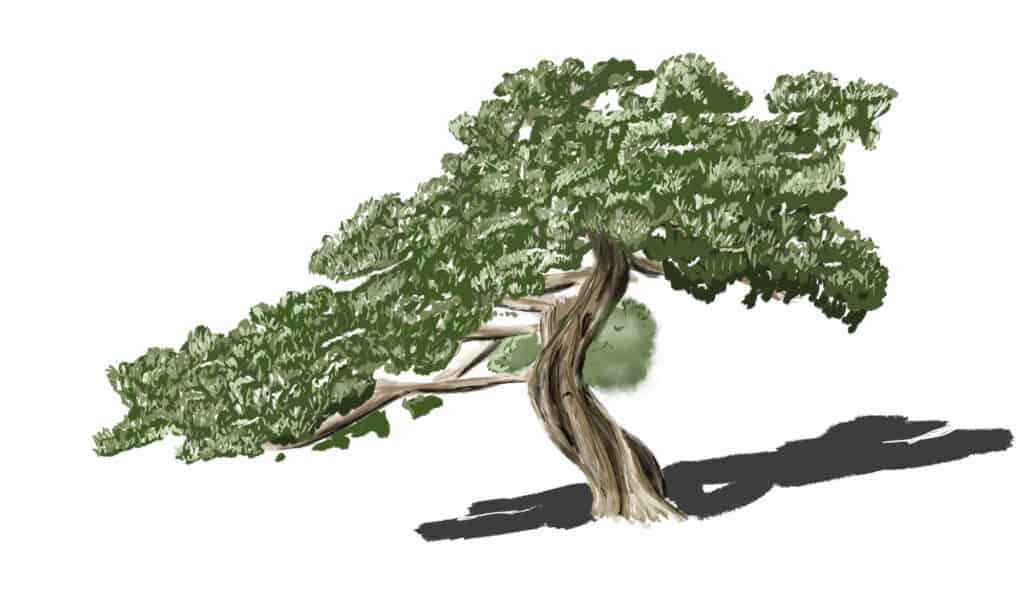
By adding highlights along the tops of the branches and some more on the canopy nearest the light. This will really make it stand out. We don’t need to add much because of the method we used earlier. Now stand back and take a look at it.
If you feel it needs more highlights, then add some more white. The trunk and branches need the most. Notice the tops of the branches and the front of the tree trunk; there are a few highlights in each area where the light is brightest. Add a little white to the tree drawing in those areas and gently blend the edges.
- Digital artists: As always, create a new layer for the highlights.
- Paper artists: White gel pens are great here, but you could also use a moldable eraser and gently pull away the color if you have not already used water on the page.
6. Finalizing Your 6 Steps to Draw a Tree
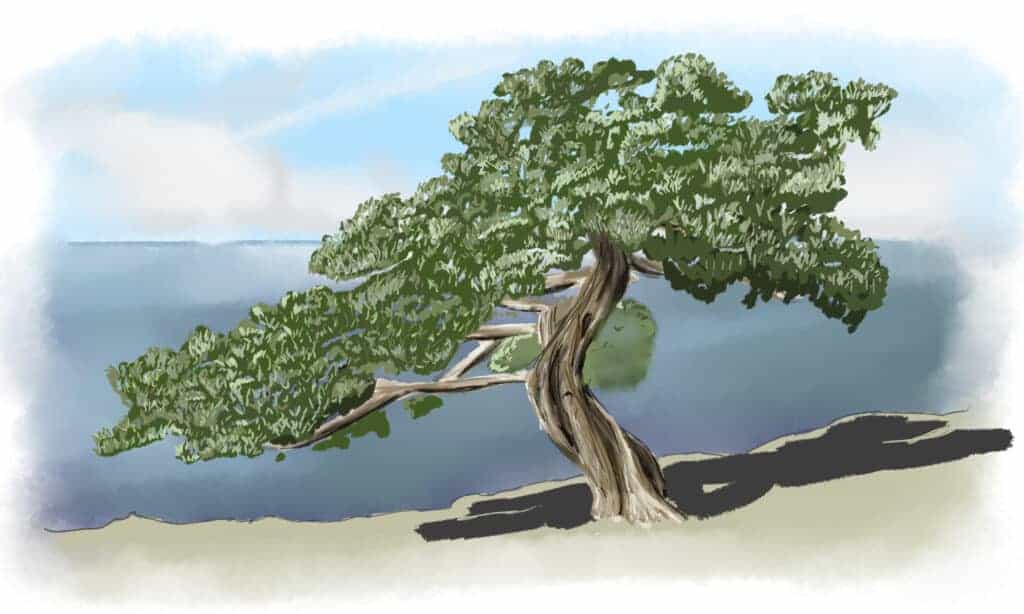
If you feel your tree needs a background, now is the time to add it. I felt my cliff-dwelling tree needed an ocean view. Think about what you want to add — tiny sailboats or rocks will help give the impression of distance. Have some fun with it. It’s your work of art.
When you're satisfied, let it sit for a day or two. Then look at it again and see if there is anything you want to add. I hope enjoyed this tutorial on the 6 steps to draw a tree.
- Digital artists: I wanted to do something with this, so I created four new layers behind the tree in Photoshop. Leaving them set at “normal,” I filled in the ground, water, clouds, and sky.
- Paper artists: Ideally, you'd want to have the background at least started before you start the tree. I would draw the tree outline, then lay down the basic colors for the background behind and around it. Color in the blues of the sky and ocean where the canopy is open.